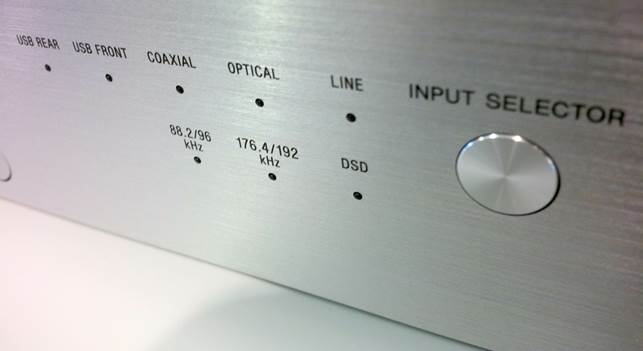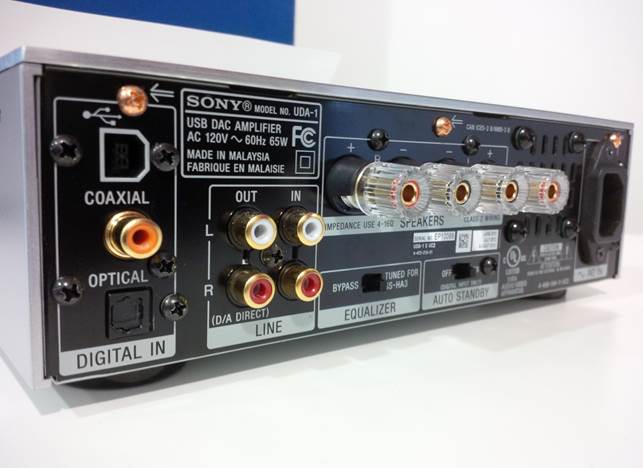Sound quality
The UDA-1
is a clean and consistent performer, that sits back and lets your speakers do
the talking, without imparting too much of its own character. Hooked up to my laptop
and feeding a pair of Q Acoustics 2020i bookshelf speakers it looks and sounds
right at home. And as a discreet desktop add on it does a dandy job of turning
a computer into a credible hi-fi source. I’m pleasantly surprised with how its
front panel USB input sounds more than adequate when streaming a touch of Van
Morrison from my smartphone, although to get the best out of it you should
introduce it to some higher quality digital delights.

Sony UDA-1 (White) USB DAC Amplifier
Not that
the UDA-1 turns its nose up at the types of lossy formats it will most likely
be called into duty to serve for many a listener. Justin Rutledge and The
Junction Forty’s Too Sober To Sleep heard at a lowly 256kbps obviously lacks
the levels of enticing detail and finesse that its FLAC alternative boasts, but
with the Sony operating in DSEE mode, instruments within the track gain more
air around them, compared to having DSEE switched off. This filter is a useful
tool for improving MP3 type audio, by making it sound less hollow or opaque.
The DSEE’s
affect is also particularly noticeable through the headphone jack with the
Rutledge album. While engaging the DSEE doesn’t increase the music’s sense of
realism, it does push instruments deeper into the soundstage and helps to
smooth sibilant edges. In this respect, the DSEE’s affect is like switching to
a more dynamic and open-backed set of headphones.
Feeding the
UDA-1 with better quality material makes the DSEE filter’s contribution less
obvious, and the music begins to sound more natural with it switched off, when
streamed at CD-quality levels. With my CD player’s S/PDIF supplying the UDA’s
coaxial socket with a 16-bit/44.1 recording of Terry Callier’s Dancing Girl,
the DAC gets into boogie mode. The soundstage seems a little deeper than it is
wide, with the higher frequencies achieving a more panoramic scale than the midband’s
notes. While the UDA-1 ensures Callier’s rhythm section nails the track’s
timing, bass and percussion stay well within the confines of the speaker plane.
Although I’m guessing this is an intentional trade off to prevent the UDA-1
from spreading itself too thinly if attempting to push the soundstage’s
boundaries.

Sony UDA-1 USB DAC Amplifier closer look
Although
its sound is relatively contained, the performance is graceful across the
frequency band, which makes it an easy listen. Changing the mood with
Goldfrapp’s Tales Of Us at 16/44.1, the final Clay track is void of digital
harshness, and the resulting sonics ebb and flow from the speakers in mellow
waves of an analogue nature. Timing is spot on, and the UDA-1 lets the track’s
progressive tempo become alluringly addictive. Bass sounds surprisingly weighty
too, given the amp’s modest 23W although this track also reveals slight
blurring in the lower frequencies.
With its
line-outs feeding my Musical Fidelity M6 pre/power amps and Audiovector
floorstanders, the Sony’s mettle is put to the test. You’ll note I’m using its
line-outs to drive my M6 preamp instead of connecting it directly to the M6
power amp, because, despite the volume knob governing its speaker and headphone
outputs, its line-level output is fixed and, therefore, unaffected by the UDA-1’s
volume control. So don’t be fooled into trying to use it as a preamp to
directly drive a separate power amp, unless you get kicks from exploding
loudspeakers.

Sony UDA-1 USB DAC Amplifier rear view
Streaming a
24/96 FLAC of Mark Knopfler’s Privateering via this setup shows that it doesn’t
feel the pressure when partnered with kit picked from a few rungs further up
the audiophile ladder. While I can clearly hear the contribution of the MF amps
as they drive my speakers with greater authority than the Sony’s inbuilt amp
can muster, the quality of its hi-res DAC shines through.
Knopfler’s
brooding vocals on Redbud Tree sound convincingly dense, with a dollop of
Dylanesque nasal character. Equally engaging is the sound of the lead guitar,
which has just the right amount of sustained echo as it falls back into the
soundstage, emphasizing the virtues of hi-res recordings done properly.
Conclusion
As an
introduction to the world of hi-res replay, the UDA-1 is a great value
integrated starter package, with a DAC section that’s ripe for feeding a
grander system. Sound wise it’s not a particularly bold performer and while
some may crave more excitement, it provides a fatigue-free listen for long-term
enjoyment.
Details · Product: Sony UDA-1 · Origin: Malaysia · Type: USB DAC amplifier · Price: $827.44 · Weight: 4kg · Dimensions: (WxHxD) 225 x 74 x
262mm · Features: In-built 2x 23W
amplifier; USB, S/PDIF and analogue inputs; Support for ALAC/
FLAC/WAV/AIFF/ MP3/AAC/WMA up to 24-bit/192kHz; DSD support
|